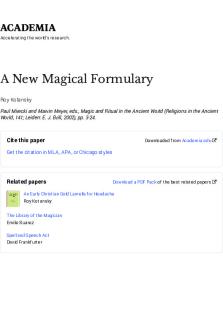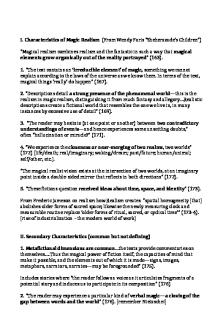Magical Realism By Wendy B. Faris PDF

| Title | Magical Realism By Wendy B. Faris |
|---|---|
| Author | Febry Ayu Valentine |
| Pages | 2 |
| File Size | 53.4 KB |
| File Type | |
| Total Downloads | 660 |
| Total Views | 738 |
Summary
I. Characteristics of Magic Realism (From Wendy Faris “Sheherazade’s Children”) “Magical realism combines realism and the fantastic in such a way that magical elements grow organically out of the reality portrayed” (163). 1. “The text contains an ‘irre...
Description
I. Characteristics of Magic Realism (From Wendy Faris “Sheherazade’s Children”) “Magical realism combines realism and the fantastic in such a way that magical elements grow organically out of the reality portrayed” (163). 1. “The text contains an ‘irreducible element’ of magic, something we cannot explain according to the laws of the universe as we know them. In terms of the text, magical things ‘really’ do happen” (167). 2. “Descriptions detail a strong presence of the phenomenal world—this is the realism in magic realism, distinguishing it from much fantasy and allegory…Realistic descriptions create a fictional world that resembles the one we live in, in many instances by excessive use of detail” (169). 3. “The reader may hesitate (at one point or another) between two contradictory understandings of events—and hence experiences some unsettling doubts,” often “hallucination or miracle?” (171). 4. “We experience the closeness or near-‐merging of two realms, two worlds” (172) [life/death; real/imaginary; waking/dream; past/future; human/animal; self/other, etc.]. “The magical realist vision exists at the intersection of two worlds, at an imaginary point inside a double-‐sided mirror that reflects in both directions” (172). 5. “These fictions question received ideas about time, space, and identity” (173). From Frederic Jameson on realism how Realism creates “spatial homogeneity [that] abolishes older forms of sacred space; likewise the newly measuring clock and measurable routine replace ‘older forms of ritual, sacred, or cyclical time’” (173-‐4). [rise of industrialization – the modern world of work] II. Secondary Characteristics (common but not defining) 1. Metafictional dimensions are common…the texts provide commentaries on themselves….Thus the magical power of fiction itself, the capacities of mind that make it possible, and the elements out of which it is made—signs, images, metaphors, narrators, narrates—may be foregrounded” (175). Includes stories where “the reader follows a voice as it articulates fragments of a potential story and induces us to participate in its composition” (176) 2. “The reader may experience a particular kind of verbal magic—a closing of the gap between words and the world” (176). [remember Nietzsche!]
Example: Metaphor made real “They treat me like an insect”; “I feel for you” “To see through someone else’s eyes” “I’ve become a new person” “It was like time stood still.” 3. “The narrative appears….as fresh, childlike, even primitive. Wonders are recounted largely without comment, in a matter-‐of-‐fact way, accepted…as a child would accept them…they thus [appear] natural” (177). 4. “Repetition as a narrative principle, in conjunction with mirrors or their analogues…creates a magic of shifting references” (177) “In Cortazar’s story ‘Axolotl’ the aquarium…is a kind of magical special mirror. Similarly, the place of Cortazar’s narrator in ‘Night Face Up,’ between modern and Aztec worlds, is a temporal double-‐sided mirror” (177). 5. “Metamorphoses are a relatively common event” (178). 6. “Many of these texts take a position that is antibureaucratic, and so they often use their magic against the established social order” (179). 7. “Ancient systems of belief and local lore often underlie the text” (182). 8. “A Jungian rather than a Freudian perspective is common…that is, the magic may be attributed to a mysterious sense of collective relatedness rather than to individual memories or dreams (183). Work Cited Faris, Wendy. “Scheherazade’s Children: Magical Realism and Postmodern Fiction.” Magical Realism: Theory, History, Community. Ed. L. Parkinson and W. Faris. Durham: Duke UP,1995. 163-‐190. Print. ...
Similar Free PDFs

6- Non-Realism and Realism
- 3 Pages

Magical AND Fantastical Elements
- 5 Pages

Sidang Skripsi Wendy
- 20 Pages

Wendy Bacon Essay
- 8 Pages

Left realism
- 6 Pages

American Realism
- 9 Pages

A New Magical Formulary
- 490 Pages

LEFT Realism
- 10 Pages

Wendy Wu Homecoming Warrior
- 2 Pages

Wendy Wu Homecoming Warrior
- 2 Pages

Enlightenment by Kant - Grade: B
- 4 Pages

Dispositional Ethical Realism
- 31 Pages

Realism AND Rational Choice
- 2 Pages
Popular Institutions
- Tinajero National High School - Annex
- Politeknik Caltex Riau
- Yokohama City University
- SGT University
- University of Al-Qadisiyah
- Divine Word College of Vigan
- Techniek College Rotterdam
- Universidade de Santiago
- Universiti Teknologi MARA Cawangan Johor Kampus Pasir Gudang
- Poltekkes Kemenkes Yogyakarta
- Baguio City National High School
- Colegio san marcos
- preparatoria uno
- Centro de Bachillerato Tecnológico Industrial y de Servicios No. 107
- Dalian Maritime University
- Quang Trung Secondary School
- Colegio Tecnológico en Informática
- Corporación Regional de Educación Superior
- Grupo CEDVA
- Dar Al Uloom University
- Centro de Estudios Preuniversitarios de la Universidad Nacional de Ingeniería
- 上智大学
- Aakash International School, Nuna Majara
- San Felipe Neri Catholic School
- Kang Chiao International School - New Taipei City
- Misamis Occidental National High School
- Institución Educativa Escuela Normal Juan Ladrilleros
- Kolehiyo ng Pantukan
- Batanes State College
- Instituto Continental
- Sekolah Menengah Kejuruan Kesehatan Kaltara (Tarakan)
- Colegio de La Inmaculada Concepcion - Cebu


